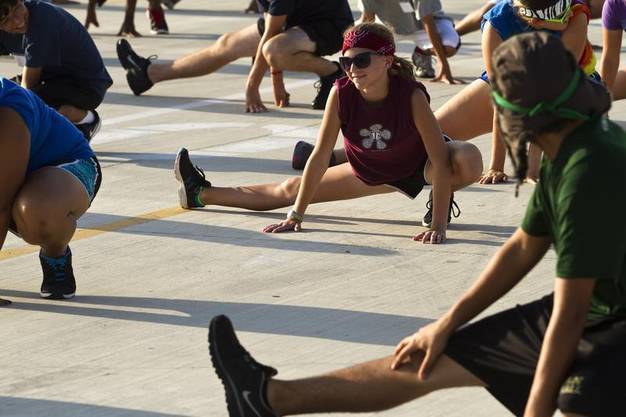Stop stretching?? Yes, you heard that correctly! The Health Guy in the marching world said to STOP stretching before you take the field. What gives?
Image 1: Marching band students performing a stretch before rehearsal
You have probably been trained since elementary school to stretch before any physical activity. That was reinforced through your middle school and high school years during mandatory gym classes, and likely further reinforced when those same concepts were applied to the marching band and drum corps field.
“It will prevent injury,” they said.
“You’ll warm-up faster,” they said.
They were wrong.
The problem is in the fact that the well-meaning PE coaches and fitness instructors in your life who ingrained this idea of stretching into your mind were themselves taught in the 1980s and 1990s. It is now 2018. The physical demands of the marching arts have evolved significantly since the 80s. Not only that, but the research on stretching, warming up for activity, and fitness, in general, has grown tremendously.
What we know now should radically change how we approach the way we prepare our bodies for rehearsals and performances. Everything we did in the past was great at that time because that was the best that we knew. Now, it is time to apply the latest research in health and fitness to the band field.
 The definition of stretching has changed in the last few years, and there are now two types of stretching: static and dynamic.
The definition of stretching has changed in the last few years, and there are now two types of stretching: static and dynamic.
Static stretching is what most of us grew up associating with the term “stretching”. It involves reaching the end range of a movement and holding it for any length of time (typically 10-30 seconds).
Dynamic stretching, sometimes referred to as a dynamic or physical warm-up, incorporates movement to prepare the body for performance. Movements begin slow and general (i.e. trunk twists) and gradually progress to quicker movements geared towards a specific activity, such as marching.
 The latest research has poked major holes in the practice of static stretching before rehearsal. It also points towards utilizing a dynamic warm-up to most effectively prepare your body for performance. Here are some of the main conclusions:
The latest research has poked major holes in the practice of static stretching before rehearsal. It also points towards utilizing a dynamic warm-up to most effectively prepare your body for performance. Here are some of the main conclusions:
1. Static stretching IMPEDES performance compared to dynamic stretching.
Two groups of elite junior (under age 18) tennis players were studied, one did a static stretch and the other did a dynamic stretch prior to playing a match. For the first 30 minutes of the match, those that did a static stretch had less speed, decreased jumping ability, and worse serve accuracy than those who performed the dynamic stretch. It took a full 60 minutes for the two groups to equalize in those three categories.1
2. Static stretching does NOT influence injury risk.
In a study of nearly 500 high school soccer players, there was NO significant difference in injury risk between those who did static stretching and those who did not. All participants performed a dynamic warm-up, but half did static stretching after the warm-up yet fared no better at avoiding injury.2,3
3. Static stretching can DECREASE muscle strength.
Multiple studies have shown that stretching can cause an immediate decrease in muscle strength.4,5 This loss in strength can last up to 1 hour depending on the amount of time spent stretching. Weakness lasting up to one hour of a rehearsal is a significant amount of time!
Now, imagine this in marching band terms; the bands who did static stretches had sloppier direction changes, worse spacing intervals, and overall poorer marching technique for 60 minutes following stretching compared to the bands who performed a dynamic warm-up.
This is monumental for the world of marching arts! The bottom line is your band, drum corps, or WGI group needs to get away from the old way of stretching. Static stretching is no longer up to date.
It is crucial spend 15 minutes at the start of each rehearsal to go through a dynamic stretch routine. This could be the game-changer to start your rehearsal more ready to execute and perform your best
If you have comments, concerns, or want tips on how to apply this information to your program please message me!
References:
1. Ayala F, Moreno-Pérez V, Vera-Garcia FJ, Moya M, Sanz-Rivas D, Fernandez-Fernandez J. Acute and Time-Course Effects of Traditional and Dynamic Warm-Up Routines in Young Elite Junior Tennis Players. PLOS ONE. http://journals.plos.org/plosone/article?id=10.1371%2Fjournal.pone.0152790. Accessed January 9, 2018.
2. Zakaria AA, Kiningham RB, Sen A. Effects of static and dynamic stretching on injury prevention in high school soccer athletes: A randomized trial. Journal of Sport Rehabilitation. https://experts.umich.edu/en/publications/effects-of-static-and-dynamic-stretching-on-injury-prevention-in-. Published November 12, 2015. Accessed January 9, 2018.
3. Applied Physiology, Nutrition, and Metabolism. http://www.nrcresearchpress.com/doi/abs/10.1139/apnm-2015-0235. Accessed January 9, 2018.
4. Reduced strength after passive stretch of the human plantarflexors J. R. Fowles, D. G. Sale, J. D. MacDougall. Journal of Applied Physiology Sep 2000, 89 (3) 1179-1188;
5. Acute Effect of a Ballistic and a Static Stretching… : The Journal of Strength & Conditioning Research. LWW. http://journals.lww.com/nsca-jscr/Abstract/2009/01000/Acute_Effect_of_a_Ballistic_and_a_Static.43.aspx. Accessed January 9, 2018.
Image 1:
https://www.victoriaadvocate.com/news/2012/aug/14/ca_ve_band_081512_185164/

